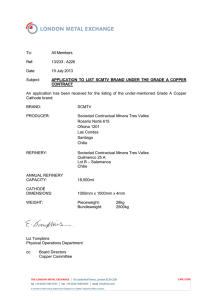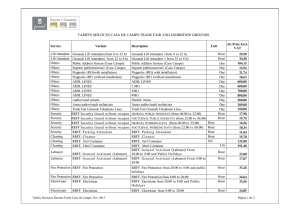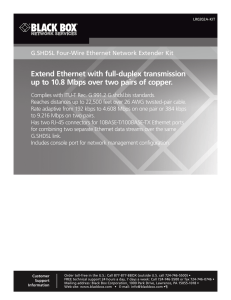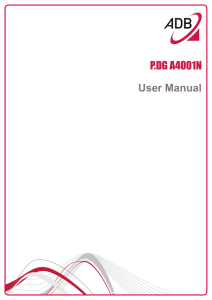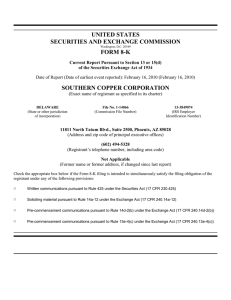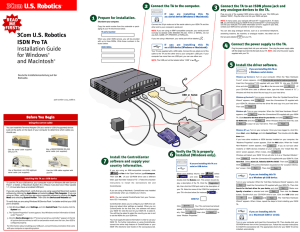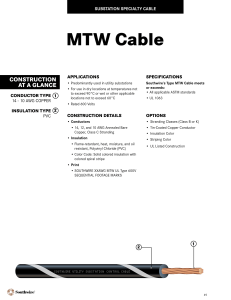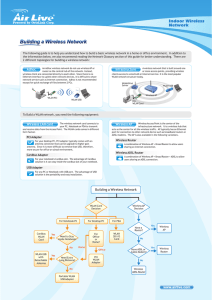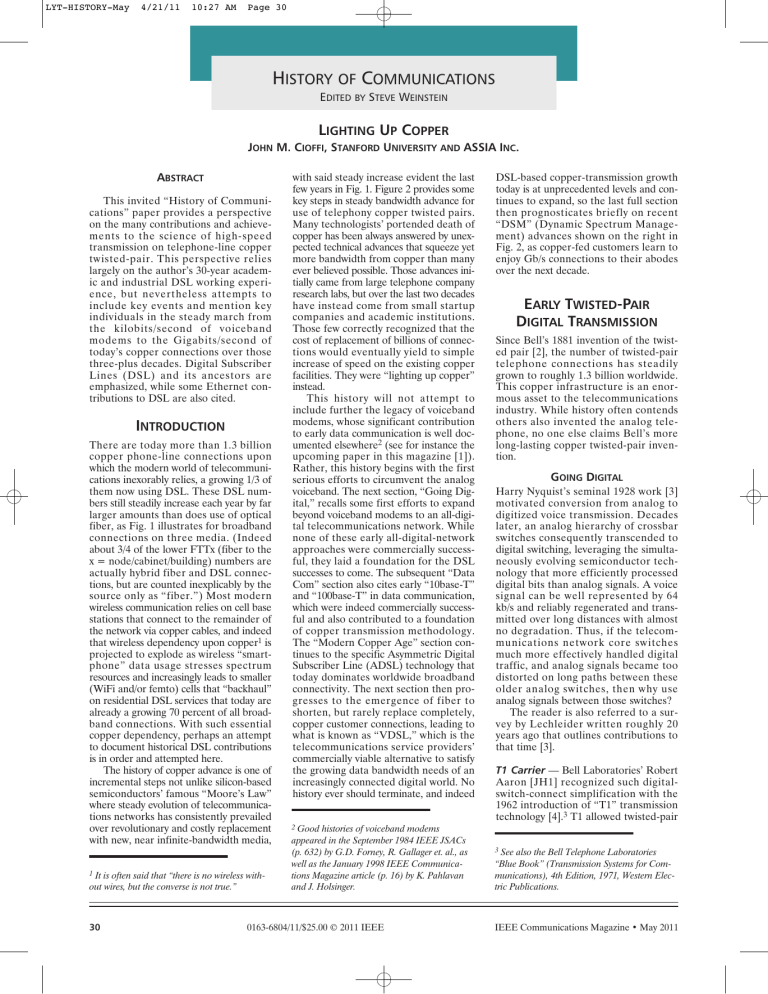
LYT-HISTORY-May 4/21/11 10:27 AM Page 30 HISTORY OF COMMUNICATIONS EDITED BY STEVE WEINSTEIN LIGHTING UP COPPER JOHN M. CIOFFI, STANFORD UNIVERSITY AND ASSIA INC. ABSTRACT This invited “History of Communications” paper provides a perspective on the many contributions and achievements to the science of high-speed transmission on telephone-line copper twisted-pair. This perspective relies largely on the author’s 30-year academic and industrial DSL working experience, but nevertheless attempts to include key events and mention key individuals in the steady march from the kilobits/second of voiceband modems to the Gigabits/second of today’s copper connections over those three-plus decades. Digital Subscriber Lines (DSL) and its ancestors are emphasized, while some Ethernet contributions to DSL are also cited. INTRODUCTION There are today more than 1.3 billion copper phone-line connections upon which the modern world of telecommunications inexorably relies, a growing 1/3 of them now using DSL. These DSL numbers still steadily increase each year by far larger amounts than does use of optical fiber, as Fig. 1 illustrates for broadband connections on three media. (Indeed about 3/4 of the lower FTTx (fiber to the x = node/cabinet/building) numbers are actually hybrid fiber and DSL connections, but are counted inexplicably by the source only as “fiber.”) Most modern wireless communication relies on cell base stations that connect to the remainder of the network via copper cables, and indeed that wireless dependency upon copper1 is projected to explode as wireless “smartphone” data usage stresses spectrum resources and increasingly leads to smaller (WiFi and/or femto) cells that “backhaul” on residential DSL services that today are already a growing 70 percent of all broadband connections. With such essential copper dependency, perhaps an attempt to document historical DSL contributions is in order and attempted here. The history of copper advance is one of incremental steps not unlike silicon-based semiconductors’ famous “Moore’s Law” where steady evolution of telecommunications networks has consistently prevailed over revolutionary and costly replacement with new, near infinite-bandwidth media, 1 It is often said that “there is no wireless without wires, but the converse is not true.” 30 with said steady increase evident the last few years in Fig. 1. Figure 2 provides some key steps in steady bandwidth advance for use of telephony copper twisted pairs. Many technologists’ portended death of copper has been always answered by unexpected technical advances that squeeze yet more bandwidth from copper than many ever believed possible. Those advances initially came from large telephone company research labs, but over the last two decades have instead come from small startup companies and academic institutions. Those few correctly recognized that the cost of replacement of billions of connections would eventually yield to simple increase of speed on the existing copper facilities. They were “lighting up copper” instead. This history will not attempt to include further the legacy of voiceband modems, whose significant contribution to early data communication is well documented elsewhere2 (see for instance the upcoming paper in this magazine [1]). Rather, this history begins with the first serious efforts to circumvent the analog voiceband. The next section, “Going Digital,” recalls some first efforts to expand beyond voiceband modems to an all-digital telecommunications network. While none of these early all-digital-network approaches were commercially successful, they laid a foundation for the DSL successes to come. The subsequent “Data Com” section also cites early “10base-T” and “100base-T” in data communication, which were indeed commercially successful and also contributed to a foundation of copper transmission methodology. The “Modern Copper Age” section continues to the specific Asymmetric Digital Subscriber Line (ADSL) technology that today dominates worldwide broadband connectivity. The next section then progresses to the emergence of fiber to shorten, but rarely replace completely, copper customer connections, leading to what is known as “VDSL,” which is the telecommunications service providers’ commercially viable alternative to satisfy the growing data bandwidth needs of an increasingly connected digital world. No history ever should terminate, and indeed DSL-based copper-transmission growth today is at unprecedented levels and continues to expand, so the last full section then prognosticates briefly on recent “DSM” (Dynamic Spectrum Management) advances shown on the right in Fig. 2, as copper-fed customers learn to enjoy Gb/s connections to their abodes over the next decade. EARLY TWISTED-PAIR DIGITAL TRANSMISSION Since Bell’s 1881 invention of the twisted pair [2], the number of twisted-pair telephone connections has steadily grown to roughly 1.3 billion worldwide. This copper infrastructure is an enormous asset to the telecommunications industry. While history often contends others also invented the analog telephone, no one else claims Bell’s more long-lasting copper twisted-pair invention. GOING DIGITAL Harry Nyquist’s seminal 1928 work [3] motivated conversion from analog to digitized voice transmission. Decades later, an analog hierarchy of crossbar switches consequently transcended to digital switching, leveraging the simultaneously evolving semiconductor technology that more efficiently processed digital bits than analog signals. A voice signal can be well represented by 64 kb/s and reliably regenerated and transmitted over long distances with almost no degradation. Thus, if the telecommunications network core switches much more effectively handled digital traffic, and analog signals became too distorted on long paths between these older analog switches, then why use analog signals between those switches? The reader is also referred to a survey by Lechleider written roughly 20 years ago that outlines contributions to that time [3]. T1 Carrier — Bell Laboratories’ Robert Aaron [JH1] recognized such digitalswitch-connect simplification with the 1962 introduction of “T1” transmission technology [4].3 T1 allowed twisted-pair 2 Good histories of voiceband modems appeared in the September 1984 IEEE JSACs (p. 632) by G.D. Forney, R. Gallager et. al., as well as the January 1998 IEEE Communications Magazine article (p. 16) by K. Pahlavan and J. Holsinger. 0163-6804/11/$25.00 © 2011 IEEE 3 See also the Bell Telephone Laboratories “Blue Book” (Transmission Systems for Communications), 4th Edition, 1971, Western Electric Publications. IEEE Communications Magazine • May 2011 LYT-HISTORY-May 4/21/11 10:27 AM Page 31 HISTORY OF COMMUNICATIONS All Digital — PSDC/Integrated Services Digital Network (ISDN) — The consequent digital core network and proliferation of digital switches left analog transmission only in the last few miles of copper closest to the customer. However, these last few miles represented over 99 percent of the wired connections, and the cost of replacing such wired connections could not be shared over many customers. Then, as now, it made no economic sense to entireley replace such “last-mile” wires.5 Thus, telecommunications engineers around the world began to think how they might better digitize this last seg4 Outside the USA, the equivalent of T1 was called E1 and used a very similar technology to carry 2.048 Mb/s (or 32, a nice power of 2, voice signals). There was no doubt that E1 used a more elegant packet layer than T1's prime-number 193 bits every 125 microseconds (8 kHz network clock), but E1 came later and introduced nothing more to digital transmission on copper than did T1. 5 A 2010 FCC Report lists the average cost of installing fiber (PON, shared connections point-to-point fiber is yet more expensive) as $2500/customer. DSL costs is under $100/customer. VDSL systems that mix some fiber and copper (and allow a higher DSL speed) cost roughly $500/customer. IEEE Communications Magazine • May 2011 400M in 2012 350 DSL Cable modem FTTx 300 Subscribers (in millions) 250 200 150 100 Many are VDSL 50 0 0 9 9 Q 21 Q 11 Q 40 9 Q 30 9 Q 20 8 8 Q 10 Q 40 8 8 Q 30 Q 20 7 Q 10 Q 40 7 0 Q 30 transmission lines between switches to carry 1.544 Mb/s digitally over roughly one mile. While simple to implement in the 1960s, T1 used a low-cost early transmission line code called “alternate mark inversion” (AMI). AMI achieved less than a few percent of the famous (Claude) Shannon capacity, well known to Aaron and others of the times, but was simple to implement and sufficient for the intended use. T1 repeaters were used to reinvigorate digital signals every mile between switches, and higher performance (longer distance) was not needed. T1 carried 24 sixty-four kilobit/second voice channels, and an extra 8 kb/s of signaling/control information.4 Two copper pairs were necessary, one for each direction of transmission. T1 enabled a digital telecommunications network. T1 might perhaps be considered the “first DSL,” and was the initial step toward lighting copper. A history of T1 transmission can be found in a separate Communications Magazine history paper by F. T. Andrews that should be published before this DSL history, but exact publication date to create a reference was not available at time of writing. Figure 1. Worldwide broadband growth (source: Point Topic). Q= 3-month quarter of year shown. ment to create an end-to-end digital system. Digital voice transmission in the last few miles did not really help voice quality, nor did it then have any other economic value or driver, but it was too much of an elegant challenge for these many researchers to ignore. Circa 1980, Ralph Wyndrum, Barry Bossick, Joe Lechleider and many others at Bell Telephone Laboratories in Whippany, New Jersey were trying to complete a plan for an all-digital network. They investigated simple transmission technologies slightly more advanced than T1, and determined that up to 160 kb/s of bi-directional transmission could be achieved over the last four to five miles of twisted-pair transmission, enough for two 64 kb/s voice channels, some overhead (16 kb/s), and 16 kb/s of data (much more than the 4.8 kb/s voiceband modems achieved in those days). Peter Adams in Britain, Kazuo Murano in Japan, and others also developed similar methods. Originally, this was called “Public Switched Digital Capacity (PSDC)” but later yielded to the name “ISDN” (Integrated Services Digital Network). The data rates contemplated did not yet anticipate a need for higher-speed services and instead focused on ubiquitous digital extension of the voice network. Their biggest challenge was simultaneous bi-directional digital transmission on a single twisted pair, which exhibits echo of digital signals from a local transmitter to a co-located opposite-direction receiver. Analog voice also had echoes that were simply addressed. 6 Digital transmission could not so simply handle echo. Digital transmission required either that time-division multiplexing (ping-pong), frequency division multiplexing, or digital echo cancellation be used to separate the two directions of transmission. A dispute arose as to which multiplexing method was best. Echo cancellation had been successful in analog voice networks for small intervals of overlapping speech, but successful digital transmission now continuously required 100 times greater precision, but echo cancellation effectively doubles the data bandwidth. So researchers began to investigate data-driven echo cancellation for this subscriber line application, which continuous data-driven echo cancellation had only months earlier been demonstrated at that 100 times greater precision for voiceband modems by a young 23-year-old engineer working in the voiceband modem area at Holmdel Bell Telephone Laboratories (BTL). The Whippany investigators (coincidentally, sans Lechleider) invited the very young designer to a meeting that would compare echo cancellation versus ping-pong (frequency division had been eliminated) for ISDN. They preferred ping-pong, so the meeting was contentious. Worse yet, after explaining the echo cancellation to a hostile audience and how it could be done, the same young engineer then had the audacity to suggest that 160 kb/s was too slow, and they really ought to consider a much higher speed, enough for video at perhaps 1.5 Mb/s, much closer to Shannon capacity for a fourmile twisted-pair telephone connection, at least in the toward-customer direction. The laughter was thunderous, and the kid was embarrassed beyond belief 6 Although use of echo suppression and even some cancellation was well-known for voice signals over very long distances (delays) at the time, but did not require the same levels of echo reduction as were required in simultaneous bidirectional data transmission. 31 LYT-HISTORY-May 4/21/11 10:27 AM Page 32 HISTORY OF COMMUNICATIONS It was going to take at least a Mb/s to light up the average consumer with excitement; ISDN was too slow and satisfied no customer need, but it did initiate DSL expertise. DSL evolution timeline Millions T1 10’s millions ISDN ADSL/ ADSL2+ 100’s millions DSM VDSL Vectored VDSL 10’s millions ? Gigabit DSL (phantoms) 1956 1978 1991 1995 1997 2001 ? 2004 1993 Figure 2. Estimates of DSL and copper predecessor introductions and volumes of deployment. (particularly when even his own boss told him to “shut up and sit down”). But that was modern DSL’s birth. I know well — that kid was me. ISDN activities migrated to the American National Standards Institute’s “T1D1.3” committee. Standards became very necessary with the 1984 ATT divestiture, which allowed for equipment other than that of Western Electric to be connected to the network. Lechleider, absent from that first echo/ping-pong-debate meeting, independently championed echo cancellation. The debates on the 160 kb/s ISDN transmission method raged in that standards committee, monitored by a fairly young man in his early 30’s from Ameritech (one of the seven just-divested operating companies) who just happened to be on his way to becoming one of the most productive standards chairmen in telecommunications history, Mr. Thomas Starr. 7 Under his guidance, a compromise proposal for 2B1Q (suggested by Peter Adams of BT) transmission (two bits as one of four levels, 80 thousand times per second) with echo cancellation was driven through standards by Starr. ISDN became reality. Nonetheless, the Japanese did their own ping-pong standard for Japan, while Germany did a wider bandwidth ISDN standard using three levels instead of four — while the American standard was adopted internationally. The Japanese and German independence forced each country on to a special standard in each subsequent generation of DSL to follow, rather than each profiting from the volume of the worldwide standard, a decision that still today costs each country’s operators a premium in DSL equipment. The time frame for this activity was the mid-to late-1980s. While T1 might have been the first DSL, ISDN might more realistically be considered first because it really did connect the subscriber digitally while T1 basically did not (usually). As such, ISDN formed a foundation for future DSLs. Many of the same people involved in ISDN, including in particular Starr, became DSL advocates and experts. However, ISDN was a commercial failure almost everywhere in the world8 — basically, ISDN was too slow to offer anything much more than analog phone service (voiceband modems eventually passed ISDN’s 16 kb/s data channel, and voice is, well, voice — digital or analog). ISDN earned itself the well-known substitute acronym “ISDN = innovation subscribers didn’t need.” 7 While Starr did not assume the chairmanship from a legacy AT&T colleague until 1989, he was clearly the leader of this American group and later internationally in the DSL area. He has been listed recently as one of the 100 most influential people in telecommunications, largely because of his unusual highly respected standards-compromising-crafting skills. 32 DATA COM Millions HDSL Contributions from the “Ethernet” community should not be ignored in a history of telecommunications copper and DSL, particularly as data and telecommunication networks have increasingly converged together in recent years. Ethernet originally started via reproduction of wireless ALOHA9 networks’ carriersense and collision avoidance on shared coaxial cables, as conceived by Bob Metcalfe in 1973 while at Xerox. 10 Ethernet’s evolution to 10base-T and its offspring have proliferated to be used on an estimated two billion wired Ethernet connections.11 They also provided practical motivating proof that higher speeds on copper were possible. Early Ethernet transmission “Manchester Encoding” was essentially a positive or negative (±1 or one bit) single square-wave cycle sent on the link roughly 10 million times/second. Manchester Encoding is as inefficient as the early T1 transmission’s AMI code, but enabled cheap 1980s manufacture of Ethernet transceivers. More sophisticated Ethernet line codes increased user bit rate to 100 Mb/s by 1995. 12 This was an important precedent to note for future DSL. MODERN COPPER AGE Repeatered T1 connections extended the digital network closer to business customer’s locations, facilitating multi(Continued on page 34) 9 ALOHA protocols were introduced in the late 1960's by N. Abramson of the University of Hawaii, as in “The ALOHA System - Another Alternative for Computer Communications',' Proc. 1970 Fall Joint Computer Conference AFIPS Press, see also IEEE Communications Magazine, August 2009, for Abramson's history “The Aloha Net: Surfing for Wireless Data.” 10 The best Metcalfe reference is his 1973 Harvard dissertation, reproduced in “Packet Communication”, MIT Project MAC Technical Report MAC TR-114, December, 1973 , but the work was done at Xerox Parc. 8 At one point, ISDN connections appear to have peaked at about 25M, but they have largely yielded to faster ADSL connections (in both directions, down and up) everywhere, so there are only an estimated millions of them still in service as in Fig. 2. 11 This estimate comes from Jag Bolaria of Linley Marketing Group. 12 A good reference on this is the IEEE 802.31995 Ethernet standard. IEEE Communications Magazine • May 2011 LYT-HISTORY-May 4/21/11 10:27 AM Page 34 HISTORY OF COMMUNICATIONS (Continued from page 32) ple digital phone connections. However, T1’s one-mile inter-repeater spacing was too short. Following ISDN standardization success, Lechleider (then at Bellcore) proposed [3] that each of T1’s two twisted pairs instead use ISDN’s improved echo-cancelled 2B1Q line code to double T1 repeater spacing to two miles. The proposed 2B1Q system basically transmitted bi-directionally two bits 400,000 times a second (as one of four levels each time) for 800 kb/s on each pair, yielding a 1.6 Mb/s total. Lechleider called this “High-Speed Digital Subscriber Line” (HDSL). By 1991, HDSL’s 2B1Q was essentially standardized in the USA after a competition with other proposals (see the section on “Line Code Wars” below). Tom Starr again skillfully guided a consensus HDSL standard/report in the American DSL standards group, then operating under the revised name ANSI T1E1.4. Europe’s “E1” T1-equivalents use 2.048 Mb/s at roughly 20 percent higher sampling rates, but also re-used the 2B1Q line code.13 Unlike ISDN, HDSL’s higher speeds increase the (imperfectly) twisted pair’s radiation. These HDSLs thus also sense radiated energy from one another, a phenomenon known as “crosstalk.” Crosstalk noise thus limited HDSL’s signal-to-noise ratio and consequently HDSL’s data rates, but at least 1.6 Mb/s (800 kb/s on each line) could reliably traverse two miles. The largest crosstalk occurs between signals traveling in opposite directions, where the near-end large transmit signal crosstalks at a high level into the attenuated signal coming from the far-end. This is called NEXT14 in copper transmission. A significant fraction of telephone lines, however, have lengths greater than two miles. Something more was needed for digital connectivity to the residential customer (above ISDN’s too slow 160 kb/s). Lechleider proposed asymmetric transmission rates in nonoverlapping upstream/downstream frequency bands to avoid NEXT. Lechleider’s asymmetry then avoided NEXT. Thus was born a basic concept of ADSL (where A = asymmetric). At this point, after getting a Ph.D. and working on disk drives at IBM for a while, I returned to Stanford as faculty in 1986, heard of ADSL and was elated, and found a way to meet Joe Lechleider, recalling my earlier “1980 laughed-out” meeting (at which he was coincidentally not present). While we differed in age by more than three decades, our early conversations and meetings were very exciting. Lechleider explained that digital applications (video to customer or information to customer) were likely to be asymmetric, thus more frequencies should be allocated to the downstream (to customer) direction than the upstream (from customer). If the upstream frequencies were limited, then the NEXT would also be limited, and all the rest of the frequency band was then NEXT-free. My earlier 1.6 Mb/s at four miles calculation had a legitimate supporter in “Uncle Joe.” Lechleider introduced me to Belcore’s Dave Waring, who successfully managed Bellcore’s DSL efforts thereafter for decades (and still does today) as well as re-acquainted me with Ken Kerpez, who made numerous contributions in modeling and fair testing of DSL over the years, despite having a limited budget with which to work for years. There was a hand-off at this point. Joe was nearing retirement age, and knew he would stay only to finish the HDSL work. He found Bellcore money to finance the first years of Stanford research in ADSL, which the National Science Foundation also matched. There was just barely enough to develop a design and to prototype. Some interesting findings emerged from this effort — basically, only a multicarrier transmission approach could achieve the data rates, and indeed if fiber were used in part of the network (say within two miles of the customer, or even several HDSLs to the two-mile point), the last two miles could sustain 6 Mb/s in ADSL. This was big — 6 Mb/s is a lot of data (even today) and certainly enough for good video (and perhaps a few simultaneous videos). ADSL had legs. Uncle Joe sent one last check as Bellcore also reduced funding overall of the area, told me it was up to me, and retired. Little did I know that there was a gauntlet to run of unpredictably epic proportion before DSL could really light up.15 LINE CODE WARS 13 While it would seem HDSL was a logical simple extension of ISDN in terms of transmission, even such a simple extension 14 15 In some cases 3 American-speed lines operating each at 800kb/s were used for a total of 2.4Mb/s with an extra 352kb/s of overhead. did not go unchallenged. The remnants of that challenge plagued DSL advance for years. AT&T Information Systems16 proposed carrier-less amplitude/phase modulation17 (CAP) for HDSL. CAP is QAM with a minor simplification that causes the carrier frequency and symbol clocks to be exactly synchronized. CAP demonstrated a slight improvement in recorded independent laboratory tests in a 1991 T1E1.4 investigation. Nonetheless, HDSL stayed with ISDN’s known 2B1Q transmission line code. The CAP proponents were disappointed about this HDSL decision, and believed CAP then deserved the next standard (ADSL). CAP was proposed for ADSL, but its use there would have been fatally flawed (as would have been also 2B1Q). The billion telephone lines exhibit wide variation (varying linear transfer characteristics and highly variable and timevariant noise spectra), which when stretched close to Shannon limits, forcing a highly variable best transmission bandwidth. The optimum Shannon spectrum often has a different on/off/on/off/.... /off nature for realistic DSL channels. On/off/on/off means the optimum transmitted spectrum places energy in separated spectrum segments, Basic transmission theory shows that a single carrier can never achieve the performance of the on/off/..../off spectrum (at least one carrier for each “on” band is necessary [5]). This effect is amplified in practice because of realistic code implementation and a 6 dB margin required for unforeseen line impulse noise changes. The Stanford work had studied this problem for years and the conclusion was irrefutable: multiple carriers were necessary, or the industry could forget 1.6 Mb/s at four miles and 6 Mb/s at two miles, or essentially DSL would have failed.18 (Continued on page 36) 16 This group later became Lucent, and a DSL modem portion of ATT then was spun off as ATT Paradyne. 17 This is a slight simplification of basic quadrature-phase modulation that exploits the symbol clock and carrier frequency can be synchronized in DSL transmission since there is no intermediate independent carrier adjustment in a twisted-pair transmission channel. Most prefer to simply call both CAP and QAM as “QAM” since the difference is trivial. 18 Some Near-End Crosstalk. X =Cross. FEXT or Far-End CrossTalk is between signals traveling in the same direction on adjacent twisted pairs. 34 I still wonder today if Joe knew well of that gauntlet before handing off with a smile on his face. examples further illustrate the theory simply in the textbook reference at website http://www.stanford.edu/group/cioffi/ee379c/ , which extends reference [5]. IEEE Communications Magazine • May 2011 LYT-HISTORY-May 4/21/11 10:27 AM Page 36 HISTORY OF COMMUNICATIONS A DIGRESSION INTO BASIC DSL TRANSMISSION THEORY This papers’ reviewers encouraged inclusion of some transmission theory here to expound upon this point. There are those who confuse a result that applies only to voiceband modems with application of its conclusion to DSL. Figure 3 will help illustrate this “multi-bowl” point. Reference [5] first made it general, expounding on some earlier results of Price, Kalet, Zervos, Salz and others that appear19 in the references of [5]. Simply stated for the purposes of this historical article, many authors make an infinite signal-to-noise-ratio (SNR(f)) approximation 1+SNR(f) ≈ SNR(f) in transmission analysis, and this approximation holds well over the entire used bandwidth of a voiceband modem. However, in DSL, SNR(f) is often zero in Shannon’s famous water-filling spectra shown in Fig. 3. The assumption 1+0 ≈ 0 is not accurate in all the unused bands (and near their edges). If one follows the assumption in these earlier works, it is equivalent to assuming that there is infinite energy (water) available to be poured from above, causing all of the Shannon bowls to overflow into one another, and thus into one very large single carrier (for which a DFE would be optimum with QAM or CAP). It is also important to note that assumptions equivalent to “generalized Nyquist bands” made by these same authors are described as DFEs in those articles but a review of filter-realization theory and Paley-Wiener criteria will reveal that discontiguous bands in that theory MUST be implemented with multiple carriers. So the authors call it single carrier, but it is really a number of carriers equal to the number of bands. However, the amount of water (energy) needed to force a single carrier and thus single band on most DSL channels greatly exceeds that available, and thus the equivalence of multi-carrier and single-carrier does not hold. Reference [5] also shows that if codes less than capacity achieving are used with any gap (or margin) above 0 dB (DSL uses a 9.8 dB gap to capacity with 6 dB of it left for time-varying noise effects), that the difference between single-carrier and multicarrier rapidly magnifies. This effect was in plain evidence in the so-called DSL Olympics test results that are mentioned later in this history. Further, it is not possible to design a single DFE that corresponds to the same three spectra, as the fundamental assumptions behind DFE realization then no longer apply (essentially the filters blow up). Correct DFE theory interpretation is that three separate DFEs are necessary for the situation in Fig. 3 (see Reference [5]). Infinite SNR (1 band) Finite SNR (3 bands) Figure 3. Plot of Shannon’s water-filling. The curve is NSR(f), the inverse of SNR(f), and energy/water is poured into the curve to lie at a constant level, with three “bowls” illustrated. This is the optimum spectra for best performance, and a single-carrier cannot achieve optimum performance unless the SNR is infinite. Use of the same three disjoint spectra in a single decision feedback equalizer causes a violation of basic filter design (causes an unrealizable filtering effect) and the assumptions underlying decision-feedback theory no longer apply and the decision-feedback system cannot be realized (instead three are needed, one for each band). The difference between a single-carrier system and multicarrier system is magnified, when as in DSL, the capacity gap is nonzero (minimum of 6 dB in DSL to account for time-varying noises). 36 (Continued from page 34) But the CAP supporters wanted their standard. I made a considerable effort to talk to the various interests to explain CAP’s fundamental-flaw for ADSL. However, I was not successful. Broadcom was formed as a spin-out of HDSL supplier Pairgain, where UCLA Professor Henry Samueli was CTO and had done a very good job implementing the first HDSL 2B1Q transmission chips that were used in the above-mentioned HDSL laboratory tests. He was joined in the Broadcom spin-out by Pairgain’s VP of Engineering Henry Nicholas. It was more expedient for them to adjust their HDSL design to CAP’s close cousin QAM (thus avoiding AT&T patents on CAP) and rapidly market a QAM ADSL chip. They thus proposed a “compromise” of doing QAM (close enough to CAP), argued similarly to AT&T Information Systems/Paradyne. This placated somewhat the CAP supporters (although they really wanted CAP) and they formed something of an anti-DMT alliance. The Broadcom founders were astute businessmen, and they knew full well they (Broadcom) could get a chip to market faster than AT&T-Microelectronics (the chip partner of Paradyne and AT&T-IS, now known as Agere) and thus uniquely capitalize on ADSL’s potentially enormous market of one billion customers worldwide. All efforts to convince them to use multiple carriers aborted because Broadcom would lose a time-to-market advantage, and that economic incentive blurred the ability to see the technical argument that a single QAM carrier would fail from a transmission standpoint. I had failed to convince anyone that the right transmission strategy was multicarrier (Uncle Joe understood, but he had retired), except for some exceptionally talented Stanford students, Jacky Chow, Jim Aslanis, and Peter Chow, and some very experienced friends from multicarrier-voiceband-modem manufacturer Telebit (a consulting job for me) CTO John Bingham and Mark Flowers. Together, that latter group became Amati Communications Corporation, which was founded in June 1991 to design and manufacturer a multicarrer ADSL modem. With less than 10 employees, and funding from Nortel’s American marketing group19 (Nortel’s (Continued on page 38) 19 A special thanks is still due today to Northern Telecom Marketing VP Stephen Fleming, now at Georgia Tech, for his faith and funding of that early effort. IEEE Communications Magazine • May 2011 LYT-HISTORY-May 4/21/11 10:27 AM Page 38 HISTORY OF COMMUNICATIONS (Continued from page 36) Canadian Bell Northern Research group wanted to do QAM and was aligned with Broadcom), Amati proposed Discrete MultiTone (DMT), a form of multicarrier that heavily favors digital low-cost implementation, with bit-swapping (a method to adapt continuously to the unique changes in noise on each, and across all the billion DSL connections. Broadcom proposed QAM (inside a system from Reliance Comm/Tech). AT&T Information Systems/Paradyne proposed CAP. Tom Starr, despite the unpopular nature of his decision, insisted on due process and laboratory testing of all three before a decision could be made. That testing came rapidly to be known as the “Bellcore ADSL Olympics” (Bellcore hosted most of the testing). All three systems were tested and results reported in [6–9] at 1.5 Mb/s. GTE offered to test anyone’s 6 Mb/s equipment at their Waltham, Massachusetts facility. Only Amati had then a system that could run this fast, so GTE tested it [10]. BT and NYNEX did impulse tests in NYNEX (now Verizon) laboratories [11]. Tom Starr convinced everyone to agree to make a line-code decision at the meeting following the testing.20 All the laboratory reports arrived at the March 1993 T1E1.4 meeting in Miami, Florida [7–11]. The measured Olympic results showed that the Amati system had large advantages over single carrier systems. The best performing QAM system was, at its best, 11 dB worse than DMT, The basic effect in Fig. 3 was evident on several of the test lines. In many cases, the QAM performance was 20–30 dB worse, so in layman’s terms DMT could operate at the same performance level with 10 to 1000 times less power. Every bit of 20 A thank you also to a non technologist Mr. R.K. Maxwell, an early Amati president and strong standards veteran who helped position this legendary Olympics for a possibility of small company success. 21 It is curious to note that the Pairgain/Broadcom system modem, not selected for DSL, was remapped to different carrier frequencies and a new analog front-end, and was successfully promoted as the first standardized cable-modem transmission method, Broadcom's first successful product. The cable application, unlike DSL, could be well addressed by QAM technology because the on/off/on/off ... spectra effect did not occur there. Even cable was “lit up.” 38 that extra capability was necessary for ADSL’s success to date. DMT’s adaptive spectra illustrated a huge effect in the testing, as theory had correctly predicted. As a result, DMT was selected.21 A photograph of the world’s first ADSL modem, the Amati Prelude, appears in Fig. 4 along with a tabular summary of some of the Olympics test results. A pen appears on top of the modem to show that while about three to four times larger than today’s DSL modems, it was not that large for a prototype. 22 ADSL thus had a line code, and the same Amati design has now appeared in nearly one billion ADSL modem chips sold over the ensuing two decades. Texas Instruments bought Amati a few years later, and I returned to Stanford. For years thereafter, and perhaps yet until today, some people think that some backhanded trick was used to obtain the Olympic victory. No such trick occurred — the difference was, and remains today, real. DMT then gained acceptance for ADSL. Motorola Semiconductor offered early DMT ADSL chips, as did also Alcatel Microelectronics, both under licenses from Amati. Many other chip vendors entered the DMT area (and Broadcom eventually acquired one of them and leads DMT ADSL chip sales today worldwide). It should be mentioned though that AT&T’s offspring, Lucent, then Paradyne-Globespan, along with Broadcom, unsuccessfully attempted a de facto CAP/QAM “single-carrier” ADSL standard for years. The confusion in the marketplace delayed ADSL introduction at least four years. The last CAP/QAM proponents finally yielded in 2003 (10 years later) when a second Bellcore Olympics was held by T1E1.4 for VDSL, and again the large DMT advantage was demonstrated convincingly and decisively. A special credit is due to Europeanbased equipment manufacturer Alcatel, who had not participated in the early ADSL line-code war or developments. Alcatel observed and respected the American standard, and helped drive it internationally. They sent top engineers for months to Amati to license and to learn the DMT designs, and then designed the world’s first DSLAMs (DSL Access Multiplexers, the banks of DSL modems in a DSL operators network) and customer22 Indeed, within four years, single chip versions had emerged. premises DSL boxes (later under the Thomson brand name) for sale. Alcatel executives Dr. Krish Prabu and Dr. Martin DePrycker realized that while many telcos still believed that 6 Mb/s was too slow for broadband, DSL was indeed an opportunity. Prabu noted in one conversation that “Alcatel will have to invest one billion dollars in ADSL before it makes a profit, but it is worth it.” Alcatel did in fact invest in standardized DMT ADSL, and remained the number one supplier of DSLAM equipment worldwide for the next 14 years. Prabu rose to COO and DePrycker to CTO rapidly after the success was evident (neither remains with Alcatel today). FAST INTERNET GTE (now part of Verizon) was not part of the pre-divesture AT&T and so often thought differently than the other “RBOCs.” 23 All the other RBOCs and most of the other incumbent telco operators worldwide liked the 1.5 Mb/s and even more the 6 Mb/s at two miles, thinking they could then enter television and video-on-demand (or “video dial tone”) markets. All the other RBOCs designed an ADSL architecture for ATM and video. All the early ADSL trials were thus video based, except GTE. Amati worked with GTE on the development of an IPbased fast-Internet connection that GTE believed would be a more realistic near-term ADSL application. GTE’s CTO Bob Olshanksy then noted that Internet traffic (emails and then some early forms of browsers, predating even Netscape) was asymmetric, 23 Regional Bell Operating Company. ATT was divested in 1984 into 7 RBOCs and ATT (which contained then Western Electric = Lucent and a long-distance company, ATT long lines and various other ATT subsidiaries like “American Bell, which became ATTInformation Systems.” Later in 1994, ATT divested Long Lines and Western Electric into ATT and Lucent, from which sprang Paradyne, then Globespan (which is today a part of Ikanos). Lucent is now owned by Alcatel. ATT Long lines is now owned by one of the RBOCs, Southwestern Bell, which purchased ATT Long Lines and 3 other RBOCs (Ameritech, Pacific Bell, and Bell South) and then renamed itself the new ATT. Verizon is a merged entity of 2 other RBOCs (Bell Atlantic and NYNEX) and GTE, along with the once competitive equivalent of Long Lines, MCI. The last RBOC, USWEST, is now part of a 3rd American telco conglomerate, CenturyLink that also contains part of Sprint and other groups. IEEE Communications Magazine • May 2011 LYT-HISTORY-May 4/21/11 10:27 AM Page 39 HISTORY OF COMMUNICATIONS but the asymmetry ratio needed to prevent TCP/IP throughput reduction was 8:1 or lower (to prevent buffer overflow for potential retransmission of errored packets while waiting for acknowledgements). The RBOCs wanted 100:1 asymmetry, other than Ameritech’s Starr, who saw some merit in GTE’s argument. (Larger asymmetry allows better downstream speed and 100:1 is better for video applications’ simple low-upstream-speed remote-control channel-changing commands.). The same DMT design easily accommodated a change in the up/down cut-off frequency, and 8:1 became the standard default for ADSL. Starr again drove a difficult compromise through the American group and fast Internet 8:1 (down:up) did make it into the first ADSL standard T1.413-1995. Roughly one year later in 1995-1996, GTE provided an Amati 6.4 Mb/s/800kb/s (down/up) fast Internet transmission system to the Microsoft Chairman/CEO’s personal residence.24 Mr. Gates was reportedly very excited with the data trial. He, as a technically savvy businessman, could see that replacement of phone lines with fiber would take a long time and a lot of money, but the copper phone wires created an immediate “fast Internet” market. Microsoft led the formation of a special interest group (SIG) to promote fast Internet with ADSL. Texas Instruments was in the SIG and promptly bought Amati. The RBOCs took note, and four of them — Pacific Bell, Ameritech, Bell South, and Southwestern Bell (SBC) — formed a purchasing consortium in the USA for fast-Internet ADSL. This first ADSL purchase ignited a worldwide initiative in fast-Internet ADSL and was extremely successful for the four purchasers. Perhaps not so coincidentally, those four telcos all eventually merged together into SBC, and then re-acquired the name AT&T through a subsequent purchase of AT&T’s dwindling long-distance assets from the 1984 divestiture (after the CAP groups had long been divested into Lucent and Paradyne and AT&T was then only a long-distance telephony company). The joint procurement group selected Alcatel as the supplier. At this point, Paradyne/Globespan (who had 24 W. Gates' newly constructed home had then only fiber running to it, and so GTE had to “dig up” his front lawn to install a copper twisted pair so he could try ADSL! DSL lit up Gates' house, and Gates himself, instead on copper. IEEE Communications Magazine • May 2011 Transmission Method (measured SNR margin) Loop 4 Loop 6 Loop 9 Loop 18 Cloop 2 Cloop 6 Cloop 7 DMT +8 dB +7 dB >+16 dB >+10 dB >+10dB +8 dB >+10 dB QAM –6 dB –8 dB +7 dB +1 dB +7 dB +2 dB +8 dB CAP <–8 dB <–8 dB <–8dB <–8 dB <0dB <0 dB –2dB Figure 4. World's First ADSL modem and its gold-medal performance from 1st Bellcore Olympics. (A “Cloop” conforms to what are known as Carrier-Serving-Area loops (roughly < 2 miles in length). supported CAP/QAM) switched to DMT and created a serious competitor to the lead DMT chip suppliers within about two years. The American DSL standards activity largely shifted to the ITU for worldwide standardization. The old data-com/Internet voiceband modem group, led by standards veteran R. (Dick) Stuart, assumed worldwide DSL-specification responsibility. The ITU then proceeded to standardize on the same US design in what is called ADSL1, G.dmt, or ITU G.992.1. It should be noted that the CAP/QAM groups tried to have the ITU standard go the “single-carrier” way, but after enormous energy in futile politics, the ITU eventually released DMT-based ADSL1 in early 2000. This direction had an appeal to the old voiceband modem technologists in that group who did not yet understand the arguments made in Fig. 3, but nonetheless they wanted a single standard. With steadfast support from Starr and European DSL standards chairman Hans Frizlen and his successor M. Gindel (ETSI TM3, later TM6), Stuart was able to avoid fracturing the DSL market with multiple standards. By 1999 the Korean government had observed the SIG and US consortia efforts and decided that such fast broad- band would be good for their national advancement. I recall having a 1998 meeting with Korean parliament representatives in which they said they did not want to be left behind the rest of the world in fast Internet, so they encouraged a rapid government-funded ADSL deployment. Within two years, Korea led the world in ADSL connections and speeds. Japan followed (although they needed a special form of ADSL that is ping-pong based so as to avoid crosstalk with their earlier pingpong ISDN (this is called “Annex C DSL” operation)). Japan’s story is fascinating in that the Japanese government had (unlike Korea) subsidized “only fiber” and no DSL. DSL use in Japan was initially forbidden. Eventually, through some political positioning by a few of us, NTT was allowed to use ADSL for the “last 100 feet” of fiber to the home, where the cost of actually installing fiber would be prohibitive. Within four years, Japan had 20 million ADSL subscribers with average line length of 2.1 km. Centillium (since acquired by Ikanos, at least the DSL part) was the supplier of the majority of the early (and present, Ikanos) DSL chips in Japan. ADSL lit on fire as the number of subscribers has continued to increase worldwide each and every quarter since 39 LYT-HISTORY-May 4/21/11 10:27 AM Page 40 HISTORY OF COMMUNICATIONS then to nearly 400 million paying subscribers at the time of publication (and still growing). Almost all of these ADSL connections are used for fast Internet service. Projections by Analysys Mason is 600 million paying DSL subscribers worldwide in 2015. THE EVOLUTION TO VDSL Very high-speed Digital Subscriber Lines (VDSL) extend DSL speeds significantly when the length of copper twisted phone line is sufficiently short, as on many of the world’s billion phone lines, and indeed that fraction of shorter lines grows rapidly as service providers deploy fiber closer, but not all the way, to their customers whenever such deployment makes good economic sense. HFC — A MOTIVATOR Shorter telephone lines permit higher DSL data rates. Following the 1993 ADSL standards decision as noted above, DSL’s competitor — the cable modem — was born. A coaxial cable has a higher possible data rate than a twisted pair, but cable systems share a single cable among many customers and thereby limit practial per-user speeds, particularly in the upstream direction where it is only cost effective to use frequencies below 40 MHz for hundreds of customers. Basically, the speed of a cable subscriber was not much different from what ADSL could offer in the mid 1990s. The cable service providers decided to break their cable system into smaller nodes with fewer shared customers by running separate fiber to each of these nodes, which is known as “Hybrid Fiber Coax” or HFC. The speeds per customer then increase to above ADSL’s early offered speeds on lines longer than two miles at least. Early cable systems were predominant only in the USA (and that is largely still true today) and UK. The potential for cable’s higher speed (and digital voice possibly being offered on cable also) so alarmed the American telephone companies and BT that most of them began committing enormous capital investment to build their own HFC systems, including adding coax (so abandoning the twisted pair). Bell Atlantic announced a $16B HFC program, while Pacific Bell announced $11B, and so on. This created a disinterest in ADSL (and no one would invest in it during this 1994–1995 window outside of the aforementioned Alcatel effort). BT had successfully deployed about 50 video-on-demand ADSL customers in 40 the Martlesham area of England. As CTO/Founder of Amati, I went to BT to observe the progress. BT suggested a need for higher speeds from fiberfed nodes within 1 km of a customer. I proposed a solution to BT on this that increased the number of DMT tones by a factor of 8 to 16. VDSL was born in that early 1994 moment. BT engineers Kevin Foster and his colleague Gavin Young 25 both became significant drivers in various UK and international standards efforts, along with me in the USA. VDSL’s higher speed revitalized ADSL interest even though the chips to do VDSL were still many years away. The initial VDSL design occurred in 1995 [12] and is essentially what is used in the later issued G.993.1 (VDSL1), G.993.2 (VDSL2), and G.993.5 (Vectored VDSL) standards. Unfortunately, the CAP/QAM proponents noted a loophole in the charter of the American T1E1.4 group in 1994 that even crafty veteran T. Starr missed, which was that the T1E1.4 group was not allowed to do standards with speeds exceeding 10 Mb/s. Someone had written T1E1.4’s charter years earlier when they thought 10 Mb/s was infinite and no one could ever go that fast on copper phone wires. VDSL was offering speeds well above 10 Mb/s. A rewritten charter with higher speed required approval by a governing standards body that just happened to be chaired by one of the CAP/QAM proponents, as bad luck would have it. This loophole was circumvented only if a new standard, not an extension of ADSL, was written (with a name change to VDSL). Writing a new standard meant that all agreements for the previous standard were moot, and the CAP/QAM people immediately objected to the use of the DMT line code. A last (at least to date) DSL line-code war thus began. The ITU also started a new standards project for VDSL, although they also were immediately allowed to extend the speeds of ADSL1, which gave rise to the ITU’s ADSL2+ (G.992.5) standard and speeds up to 25 Mb/s. Efforts to standardize VDSL then shifted directly to the international 25 Gavin deserves special mention for his tireless efforts to promote DSL in the DSL Forum as the head of the technology area for that group and as a very open Chairman of the UK Ofcom/NICC standards group after leaving BT and rising to CTO of UK-based DSL early leader Bulldog (acquired by Cable and Wireless). Kevin went on to lead BT's DSL efforts until the present day. group with the American and European DSL standards people en mass migrating their participation to the ITU. Lucent blocked every ITU effort to standardize VDSL using DMT for roughly seven years. Two enormous blocks of companies, the VDSL Alliance (DMT) and the VDSL Coalition (CAP/QAM) formed. TI chaired the Alliance while Lucent chaired the Coalition. Both groups had more than 50 companies. Much money was invested in VDSL designs on both sides. None of the many efforts at ITU compromise was successful. During the period, Swedish Telia Research’s Michael Isaksson devised an ingenious DMT method [13] to allow very precise carrier allocation to either direction of transmission, which is known as “digital duplexing” in standards. Isaksson originally used the title of “Zippering.” This method also enabled the future invention of what is called “vectoring” to eliminate crosstalk and substantially further increase VDSL data rates. This digital duplexing furthered DMT’s advantage to a much more flexible variation of asymmetry ratio than was possible with QAM or CAP. In fact, today’s VDSL can offer symmetric transmission. In 2001, Tom Starr offered to lead an American “VDSL Olympics” testing effort with report to the ITU of results for short VDSL loops under a wide range of noise conditions. The debate over which tests to run continued for 18 months with QAM/CAP proponents trying to insert only “single-bowl” test channels where a single carrier would perform almost as well as DMT, and the DMT group trying to insert at least some “multi-bowl” channels where DMT’s advantage would be much more evident. Eventually a test plan was agreed under Starr’s very careful guidance. The compromises ingeniously occurred on the testing, not on the line code. Dave Waring and Ken Kerpez of Bellcore, then renamed Telcordia, and BT’s Kevin Foster both volunteered to host and run the same tests on each of four supplied systems: two DMT VDSL systems, one from Alcatel (through ST Microelectronics) and one from Ikanos, a CAP VDSL system from Lucent, and a QAM VDSL system from Metalink, were all tested in early 2003. The DMT VDSL system had overwhelming performance advantages (the same effect as 10 years earlier again in plain evidence) and was recommended by the American group to the ITU for the VDSL standard along with a strong united American telco voice that they would be using IEEE Communications Magazine • May 2011 LYT-HISTORY-May 4/21/11 10:27 AM Page 41 HISTORY OF COMMUNICATIONS 3500 2500 23/3 MORE MOTIVATORS HFC continues to be used by the cable companies, and the recent DOCSIS 3 standard uses DMT like capabilities to increase transmission speeds further to peak per-user speeds of 50 Mb/s or more. (However, sharing reduces con26 Triple play means data, digital voice, and video services within the same basic broadband connection. IEEE Communications Magazine • May 2011 6/6 2000 1500 10/10 13/13 1000 500 0 1 2 3 4 5 6 7 8 9 10 11 12 13 14 15 16 17 18 19 20 21 22 23 24 25 26 27 28 29 30 31 32 Reach test # Single-Carrier QAM/CAP VDSL Olympics test results 3500 VDSL USES 16/1 23/3 3000 2500 Length (ft) Asian deployments of VDSL abound in Korea and Japan, to commercial speeds as high as 100 Mb/s, but these Asian uses to date have been largely on fiberto-the-basement deployments where the DSL links the basement to the living units. These line lengths are typically 100 meters or less, so do not stress the VDSL transmission technology. There are tens of millions of such VDSL connections in each of Japan and Korea. The first significant outside-plant use of VDSL was by AT&T in the USA in its 2004-started 25Mb/s U-verse triple play26 DSL offering, on which there are now roughly 3M customers and growing rapidly. Substantial deployments of smaller size also occurred slightly later by Swisscom in Switzerland and by Chunghua Telecom in Taiwan. Qwest in the USA also has substantial VDSL deployment, and it appears after some fiber to the home connections by Verizon that they also will have a broadband network that is a majority of DSL users (ADSL and VDSL). Telcos the world over are presently migrating to VDSL. 16/1 3000 Length (ft) DMT VDSL in the future. The reported test results from that second Olympics are shown in Fig. 5 [14]. The ITU then selected DMT in a compromise that had a CAP/QAM option in the VDSL1 standard appendix with essentially Ikanos’ DMT VDSL design in the main body. However, the ITU started a new DMTonly VDSL2 standard that was closer to ADSL2+ called G.993.2 (VDSL2). Subtle changes from VDSL1 to VDSL2 ensured that no chip manufacturer had a pre-existing chip that would comply with G.993.2 at the time of the compromise, essentially leveling the VDSL2 competition for VDSL sales (while delaying all) so that CAP/QAM companies would have time to switch. Both the VDSL1 and VDSL2 base DMT designs are identical to the original design in VDSL2, but VDSL1 differs from VDSL2 in some other ways that involve unusual framing, initialization processes, and code choices unrelated to modulation. 10/10 6/6 2000 13/13 1500 1000 500 0 1 2 3 4 5 6 7 8 9 10 11 12 13 14 15 16 17 18 19 20 21 22 23 24 25 26 27 28 29 30 31 32 Reach test # DMT VDSL Olympics test results Figure 5. 2nd Bellcore (Telcordia) Olympics Results for 32 test channels. Each division vertically represents 500' of length at same performance level in each plot. Different colors are different speeds across the 32 loops tested. Data Rate (Mb/s) Channels 1–6 Channels 7–12 Channels 13–16 Channels 17–28 Channels 29–32 Downstream 10 13 16 22 6 Upstream 10 13 1 3 6 tinuous speeds below these peaks when more than one customer is active on the shared coaxial cable.) The telcos’ fear of continued HFC improvements prompted most to consider fiber to the home as a passive optical network (PON), a very expensive endeavor. As noted earlier in footnote 6, the cost of fiber (PON) to a US home is on average $2500/subscriber. Compared to a ADSL cost of under $100, and a VDSL cost of roughly $500, PON is thus an unjustified expense for a broadband service that will have rapid price erosion, particularly when VDSL offers at least the same unshared speed per customer. Nonetheless, some telcos attempted (or plan to attempt) PONs that are essentially the same as HFC except the fiber/copper point becomes a 41 LYT-HISTORY-May 4/21/11 10:27 AM Page 42 HISTORY OF COMMUNICATIONS passive optical splitter. It should be noted that VDSL does of course endure the cost of using some fiber, but this fiber does not go to the customer but rather to a node that typically services hundreds of customers so that the most expensive per-customer part of PON or fiber-to-the home, the labor/construction to replace the last segment of copper, is averted. PON efforts have been slower than predicted to garner customers, and/or abandoned for high costs,27 but in the early 21st century motivated further improvement of VDSL speeds as detailed in the next section. DYNAMIC SPECTRUM MANAGEMENT FURTHER IMPROVES DSL Dynamic Spectrum Management (DSM) added a new speed-magnifying dimension to DSL. Conceived in 2000 [15], DSM focuses on the management of the DSL’s effect on neighboring DSLs. The collection of a network of co-existing DSLs can be significantly improved if rates, power, power spectra, and codes are managed to match the dynamics of noise (including crosstalk from other users). DSM was thus an excellent counter to what had theretofore been perceived as higher possible broadband speeds on PON or DOCSIS 3 HFC. The first DSM efforts occurred at Stanford under funding from Intel, Bellcore, NSF, and France Telecom. DSM does not directly involve line-code choice nor interoperable equipment specification, but rather exploits management of a collection of DSLs. It is not immediately obvious that reduction of transmit power can increase a DSL’s speed, but it can with DSM. Through a series of standards contributions to the American T1E1.4 group, doubters of such counterintuitive reasoning gradually relented slightly and a DSM standards effort was initiated in 2002, again with its leader Starr helping the project progress. Telephone lines in the USA are the longest and oldest for demographic and historical reasons, and thus DSM’s first impacts 27 This sentence inevitable begs the Verizon FiOS question, where new fiber PON is no longer being deployed, but drops from existing fiber PONs to customers near those fiber PONs is still ongoing. Also, French regulator Arcep is presently soliciting inputs for a national VDSL program (previously prohibited in favor of PON) and all early indications are that this is an important future cost-effective direction. 42 were in the USA. By 2007, a standard/report [16] had issued from the T1E1.4 group (by then called ATIS NIPP-NAI). ASSIA Inc. was formed in partnership with the USA’s largest DSL service provider AT&T in 2003, which then proceeded to be the world’s first DSM adopter (now used on 17M AT&T DSL customers), and ASSIA has grown rapidly to a rising mid-size company, bring DSM-based DSL speed increases around the world. While I started ASSIA, the technical staff there contains some of DSL’s brightest young minds in George Ginis, Wonjong Rhee, Peter Chow, Mehdi Mohseni, Chiang-Yu Chen, Iker Almandoz, Phil Bednarz, Marc Goldburg, Chan Soo Hwang, and Bin Lee. They’ve done more to advance DSL than any single effort predating them. At the time of publication, roughly 50M DSL subscribers benefit from daily DSM use, and that number will rapidly expand. The US standards effort eventually defined three levels of DSM [16]. The first level addresses time-varying noise on a DSL connection. Most DSL systems are subject to a variety of noises induced by appliances, lights, electronic devices, radio broadcasts, as well as other DSLs’ crosstalk that vary with time. The amount of noise variation can be substantial. Intermittent noises of severe significance occur on at least 20 percent of all ADSL connections at moderate speeds and are of importance on 80 percent of DSLs where the line is stressed to its theoretical limits. These noise variations are often so large that they cause several modem re-trains each day (about a 30–90 second outage). The re-trains led to unhappy customers, who thus call and complain, and the DSM-less DSL service provider then too conservatively throttles the DSL service speed (to prevent the expense of handling calls and technician dispatches from overwhelming profits). If the service provider knows those lines having the problem, they can avoid speed increase on only those; however, the other lines can be increased in speed. Thus DSM substantially increases DSL network coverage (higher speeds to more customers on average). DSM Level 2 extends DSM Level 1 by adding a frequency-selective politeness (using less power whenever possible to reduce overall crosstalk) to management of DSLs and further increases data rates. DSM Level 3 introduced the concept of vectored DSLs [17]. Vectored DSLs exploit Isaksson’s digital duplexing to remove FEXT between DSLs (recalling NEXT was already reduced/eliminated by non-overlapping asymmetric spectra). Such FEXT removal substantially increases speeds. Vectoring thereby exposes the DSL even more so to tiny noise variations on the remaining noises (so Level 1 and Level 2 management become even more necessary with Level 3). The net effect is basically that 100 Mb/s DSL service at 1 km ranges becomes possible. The ITU has released G.993.5 vectored VDSL that allows implementation of DSM Level 3. While not yet deployed, vectored VDSL promises higher per-customer continuous speeds than any optical or HFC systems on the market today. It is expected to appear in 2012. Level 3 also includes vectored VDSL’s offsprings (Gigabit DSLs or “phantom” DSLs) that were first invented in 2004 [18]. CONCLUSIONS The impact of DSL on telecommunications has incrementally evolved over the past two to three decades despite projections throughout that period that copper had outlived its usefulness. Indeed, the contrary proved true that DSL largely saved the fixed-line telecommunications industry as analog voice customers transformed into broadband customers. Many researchers and individuals contributed to DSL’s progression, and today DSL is a major industry that produces over $120B annually in service revenue to DSL service providers. DSL is a good example of the match of rational economic practicality of “what can we do with what we have?” instead of “let us spend lots of money on a major infrastructure change that we are not sure we need.” Nonetheless, the DSL area is often dismissed as passé without real understanding of its impact and continued growing future. There will be continued development in DSL to yet higher speeds and expanded deployment. It is likely that Wi-Fi and small “femto” cells will proliferate smartphone connectivity enormously in the coming decade, allowing any type of information (voice, data, video or other) to most any reasonable point on earth. These smaller cells must be connected to the telecommunications network/Internet by wired backhaul, therefore largely DSL. DSL is thus lighting up broadband worldwide. While I was asked to write this history now, I dream that some younger person today will, in a few decades, write more DSL history to come. Hopefully, it continues to be a good story for us all. IEEE Communications Magazine • May 2011 LYT-HISTORY-May 4/21/11 10:27 AM Page 43 HISTORY OF COMMUNICATIONS ACKNOWLEDGEMENTS Special thanks are deserved by S. Timmerman, P. Chow, M. Goldburg, and G. Ginis, all of whom provided helpful comments on early drafts of this paper. REFERENCES [1] D. Falconer, “History of Equalization 1860–1980,” IEEE, to appear 2011, IEEE Commun. Mag. [2] Lechleider “A Review of HDSL Progress,” 6, IEEE, Aug. 1991, IEEE JSAC, vol. 9. [3] J. Cioffi et al., “MMSE DFEs and Coding: Parts I and II,” 10, IEEE, Oct.1995, IEEE Trans. Commun., vol. 43, pp. 2582–604. [4] M. Isaksson, In, or Relating To, VDSL, patent number 7,113,549 USA, Sept. 26, 2006. [5] G. Ginis et al., Dynamic Digital Communication System Control, patent no 7,158,563 Jan. 2, 2007 (filed 2001). [6] D. Falconer, “History of Equalization 1860–1980,” IEEE, to appear 2011, IEEE Commun. Mag. [7] J. M. Cioffi, ADSL Compatible DMT Apparatus, patent no 5,673,290 USA, Sept. 30, 1997. [8] J. M. Cioffi, High Speed Multiple Loop DSL System, patent no 7,639,596 USA, Dec. 29, 2009 (filed Mar. 25, 2004). [9] J. M. Cioffi and G. Ginis, “Vectored Transmission for DSL Systems,” no. 5, June 2002, IEEE JSAC, vol. 20, pp. 1085–104. [10] A. G. Bell, “Telephone Circuit,” 244426 USA, July 19, 1881. [11] M. R. Aaron, “PCM Transmission in the Exchange Plant,” 1, AT&T, Jan. 1961, Bell Systems Tech. J., vol. 41. [12] Vendor VDSL Olympics Presentation, Telcordia and BTExact, Anaheim, CA, June 18, 2003, T1E1.4 Contribuions 2003-600 through 2003-614. [13] Members of Technical Staff, Bell Telephone Laboratories, Transmission Systems for Communications, Westerm Electric Technical Publications, 1971, vol. 4th Edition. [14] Results of Transmission Tests on an aDSL Transceiver Prototype from Reliance COMM/TEC and Bellcore, Bellcore, Miami, FL, Mar. 8, 1993, ANSI T1E1.4 contribution 1993-030. [15] Results of Transmission Tests on an ADSL Transceiver Prototype from AT&T Paradyne, Bellcore, Miami, FL, Mar. 8, 1993, ANSI T1E1.4 Contribution 1993-032. [16] Results of Transmission Tests on an ADSL Transceiver Prototype from Amati Communications Corpoation, Bellcore, Miami, FL, March 8, 1993, ANSI T1E1.4 Contribution 1993-031. [17] Alliance for Telecommunications Industry Standards (ATIS), Dynamic Spectrum Management, ATIS NIPP-NAI Committee, May 17, 2007. ATIS-0600007. [18] Bell Communications Research, Description of the Transmission Tests Performed on ADSL Transceiver Prototypes at Bellcore, ANSI T1E1.4 Standards Contribution 1993029, Mar. 8, 1993. ADDITIONAL READING [1] H. Nyquist, “Certain Topics in Telegraph Transmission Theory,” Bell Systems Tech. J., 1928. BIOGRAPHY J OHN M. C IOFFI is Chairman and CEO of ASSIA Inc, a Redwood City, CA based company pioneering DSL management software sold to DSL service providers, specifically known for introducing Dynamic Spectrum Management or DSM. He is also the Hitachi Professor Emeritus at Stanford University, where he held a tenured endowed professorship before retiring after 25 full-time years. Cioffi received his BSEE, 1978, Illinois; Ph.D.EE, 1984, Stanford; Honorary Doctorate, University of Edinburgh 2010; Bell Laboratories, 1978–1984; IBM Research, 1984–1986; EE Prof., Stanford, 1986-present. He also founded Amati Com. Corp in 1991 (purchased by TI in 1997 for its DSL technology) and was officer/director from 1991–1997. He designed the world’s first ADSL and VDSL modems, which design today accounts for roughly 98 percent of the worlds over 350 million DSL connections. He currently is also on the Board of Directors of Alto Beam and ClariPhy. Various other awards include IEEE Alexander Graham Bell Medal (2010), Economist Magazine’s 2010 Innovation Award, International Marconi Fellow (2006); Member, United States National Academy of Engineering (2001); International Fellow United Kingdom’s Royal Academy of Engineering (2009); IEEE Kobayashi Medal (2001); IEEE Millennium Medal (2000); IEEE Fellow (1996); IEE JJ Tomson Medal (2000); 1999 U. of Illinois Outstanding Alumnus and 2010 Distinguished Alumnus. He has published several hundred technical papers and is the inventor named on over 100 additional patents, many of which are heavily licensed in the communication industry. Get to know your power supply! Combining OMICRON Lab’s Bode 100, Vector Network Analyzer with the new Picotest Signal Injectors enables you to perform high-fidelity measurements of: Non-Invasive & traditional Stability PSRR Input & Output Impedance Reverse Transfer ... and many other important power supply parameters in the range from 1 Hz - 40 MHz For FREE application notes and more, please visit: www.omicron-lab.com & www.picotest.com/blog Smart Measurement Solutions Smart Measurement Solutions IENYCM2879.indd 1 IEEE Communications Magazine • May 2011 4/6/11 4:35:23 PM 43

